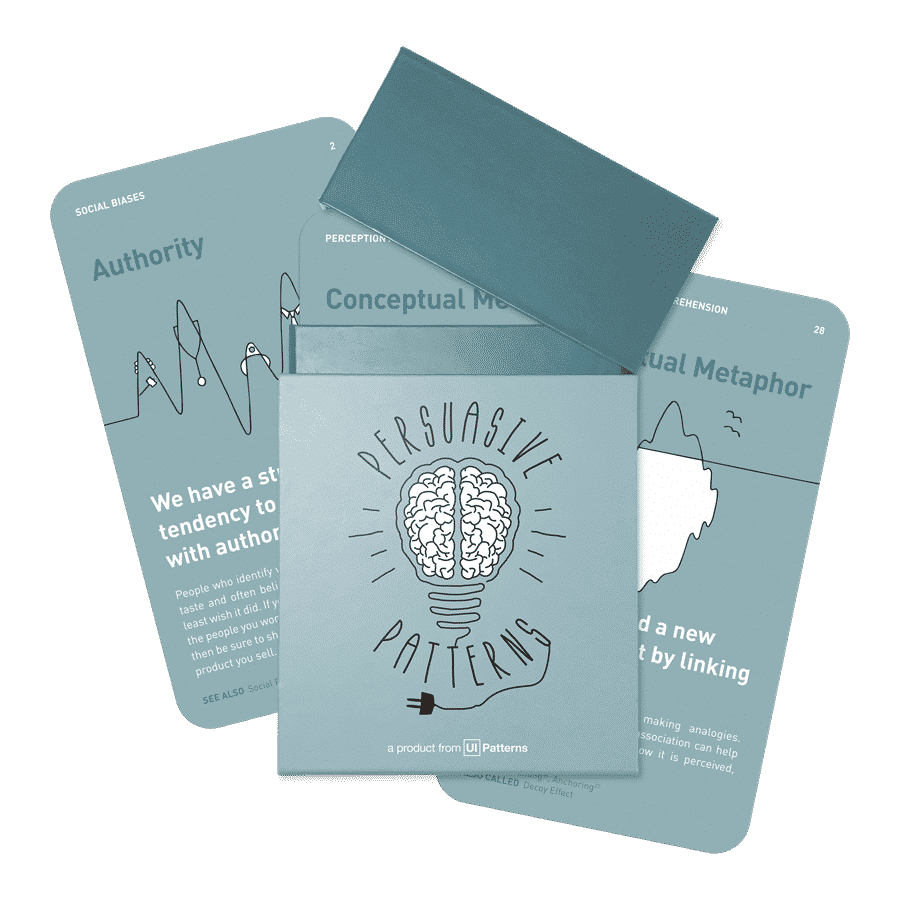Persuasive Technique
Also called: Precommitment Strategies, Behavioral Contracts
This persuasive pattern is part of the Persuasive Patterns printed card deck.
The Persuasive Patterns Card Deck is a collection of 60 design patterns driven by psychology, presented in a manner easily referenced and used as a brainstorming tool.
Get your deck!Commitment Devices are tools or mechanisms that help users stay aligned with their long-term goals by providing structures or barriers that prevent them from acting against their better judgment.
Commitment devices are surprisingly common in everyday life. Imagine you’re serious about starting a new exercise routine but know you struggle with early morning motivation. You pack your gym bag the night before and place it by the door (Commitment Device). This creates a physical barrier – you’d have to actively choose to move the bag to avoid your workout. The act of pre-committing by packing your bag strengthens your resolve and makes skipping the gym feel like a more deliberate decision.
Many fitness apps leverage this technique – for instance by allowing you to schedule your workout in advance and even invite a friend to join virtually (digital commitment device). This creates a social layer of accountability, making it harder to back out and increasing the likelihood of sticking to your exercise goals.
The study
One of the key studies on Commitment Devices was conducted by Giné, Karlan, and Zinman (2010), focusing on the impact of financial commitment mechanisms on smoking cessation. The study explored how offering individuals the option to voluntarily place money into a savings account, which they could only access if they successfully quit smoking, affected their likelihood of quitting.
The findings revealed that individuals who opted into the commitment device were significantly more likely to quit smoking compared to those in the control group. In fact, the study found that the likelihood of quitting smoking increased by approximately 30% among those who used the commitment device.
This study demonstrates the effectiveness of Commitment Devices in helping individuals align their immediate actions with long-term goals, highlighting the power of these mechanisms in behavior change interventions.
Giné, X., Karlan, D., & Zinman, J. (2010). Put your money where your butt is: A commitment contract for smoking cessation. American Economic Journal: Applied Economics, 2(4), 213-235.
Commitment Devices are designed to bridge the gap between a user’s present impulses and their future aspirations. The primary goal is to create mechanisms that nudge users towards actions that align with their long-term goals, effectively reducing impulsive decisions or behaviors that could lead them astray. These devices can take many forms, from financial commitments, such as prepaying for a gym membership to encourage regular attendance, to technological solutions, like apps that lock users out of certain websites during designated work hours.
The potential of Commitment Devices lies in their ability to reduce cognitive dissonance by aligning immediate actions with long-term goals, making it easier for users to maintain consistency and avoid behaviors that undermine their aspirations.
Commitment Devices operate on two key psychological principles: commitment escalation and anticipated regret, both of which reflect the human desire for self-regulation.
Commitment escalation indicates that once a commitment is made, individuals tend to invest further resources to justify it. Commitment Devices create an initial investment by asking users to “put something on the line” upfront, such as a financial deposit, a public declaration, or scheduling time in advance. This pre-commitment increases the perceived value of the goal and motivates continued effort, reducing the likelihood of abandoning the initial investment.
Commitment Devices also leverage the fear of future regret - our anticipated regret. This principle suggests that individuals anticipate feeling regret if they fail to uphold their pre-commitment, which serves as a motivator. For example, pre-paying for a language learning app creates a fear of wasting money if the app is not used, incentivizing engagement with the learning materials.
Another psychological principle at play is time-inconsistent preferences. Individuals often value immediate rewards over future benefits, leading to decisions that favor short-term gratification. This phenomenon, known as hyperbolic discounting, explains why individuals may struggle to align present actions with long-term goals.
Commitment Devices introduce mechanisms that help individuals precommit to actions that align with their long-term goals, reducing the likelihood of succumbing to immediate temptations. This can include binding agreements, financial stakes, or social pressures, which increase the cost of deviating from the desired behavior and reinforce self-control.
Commitment Devices also function as behavioral nudges, subtle interventions that influence decision-making without restricting choices. By making it easier to follow through on long-term goals, such as through deadlines, financial incentives, or supportive environments, these devices steer individuals toward desired behaviors.
Commitment Devices can also mitigate cognitive dissonance, the discomfort that arises when one’s actions contradict their beliefs or goals. By promoting behaviors that align with long-term aspirations, Commitment Devices reduce dissonance, fostering consistency between actions and goals.
Commitment Devices are closely related to the pattern of Commitment & Consistency. This pattern relies on the psychological principle that individuals tend to act in ways consistent with their previous commitments. Once a commitment is made, such as a public declaration, financial deposit, or a scheduled action, people feel a strong urge to follow through to maintain consistency. This aligns directly with how Commitment Devices function, reinforcing self-regulation by leveraging the need for consistent behavior.
Another related pattern is Cognitive Dissonance, which addresses the discomfort individuals feel when their actions contradict their goals or beliefs. Commitment Devices mitigate this dissonance by encouraging actions that align with one’s long-term aspirations. This reduces the gap between intentions and actions, helping individuals maintain consistency between what they aim to achieve and what they actually do.
Temptation Bundling is another pattern related to Commitment Devices. This pattern involves coupling a desired but hard-to-achieve behavior with a more enjoyable activity. For instance, allowing access to a tempting audiobook only while exercising can motivate individuals to visit the gym. This pairing increases the likelihood of maintaining desired behaviors, similar to how Commitment Devices align actions with long-term goals by introducing immediate incentives.
Designing products with Commitment Devices
Commitment devices are a powerful tool for influencing behavior and helping users achieve their goals. By strategically introducing pre-commitments and adding costs to non-compliance, you can empower users to overcome procrastination and stay on track. But how can you effectively integrate commitment devices into your product or service?
The key lies in understanding the different types of commitment devices and how they can be tailored to specific goals. Here’s a breakdown of the various categories:
- Social commitment devicesbr />These leverage social pressure to promote adherence. Public declarations of goals or progress updates shared through social media create a sense of accountability, making users less likely to abandon their commitments for fear of social disapproval. Imagine a language learning app that allows users to connect with other learners and share their daily progress. This fosters a sense of community and motivates individuals to stay on track, knowing their peers are watching. Social commitment devices can be particularly effective for individuals who thrive on external validation and social support.
- Friction commitment devices
These add a layer of inconvenience to opting out of a desired behavior. Imagine using smaller lunch boxes to deter overeating or setting up automatic transfers to a savings account, making it more cumbersome to access the funds. A productivity app could leverage friction commitment devices by allowing users to schedule tasks in advance and automatically block out dedicated work time in their calendars. This creates a hurdle to skipping these pre-committed work sessions. Friction devices are ideal for behaviors where reducing the ease of opting out can significantly increase adherence. - Financial commitment devicesbr />Financial stakes introduce a potential loss if users deviate from their goals. Depositing money towards a fitness class or using a service with a pre-paid subscription creates a financial incentive to follow through. A budgeting app could offer a “commitment challenge” where users pre-deposit a set amount towards a specific savings goal. Failing to meet the goal within a timeframe could result in forfeiting the deposit, creating a financial penalty for non-adherence. Financial commitment devices can be highly motivating, but it’s important to use them cautiously and ethically. Consider offering a range of financial stakes to cater to different risk tolerances.
Choosing the right device
The most effective commitment device will depend on the specific goal and user preferences. For individuals who thrive on social support, social devices might be ideal. For those seeking to automate healthy habits, friction devices can be powerful. Financial devices, while effective, should be used cautiously and might not be suitable for everyone, particularly those with financial constraints. Consider a weight loss app that offers a variety of commitment devices. It could allow users to share their goals with friends and family (social), pre-schedule healthy meal deliveries (friction), or require a deposit that is only refunded upon reaching weight loss milestones (financial). By providing a range of options, the app caters to different user preferences and increases the likelihood of finding a device that resonates with each individual.
While commitment devices are a valuable tool, they are just one piece of the puzzle. Here are some additional strategies to consider:
- Pre-commitments
Encourage users to simply declare their intentions upfront. While not as strong as a formal commitment device, pre-commitments can still serve as a psychological anchor. A meditation app could prompt users to set daily meditation goals each morning. This simple act of pre-commitment can increase the likelihood of following through with the practice. - Temptation bundling
Pair a desired behavior (like exercise) with an enjoyable activity (like listening to a podcast) to make it more appealing. A music streaming service could create playlists specifically designed for workouts, making exercise a more enjoyable experience. - Implementation intentions - if-then plans br />Develop “if-then” plans that specify how users will respond to specific situations. For example, “If I feel stressed, I will take 5 deep breaths.” A productivity app could prompt users to create these “if-then” statements for common procrastination triggers, such as setting an intention to close distracting social media tabs whenever they feel the urge to check them.
The goal is to provide users with the tools and support they need to stay committed to their goals. By understanding the different types of commitment devices and using them strategically, you can design products and services that empower users to achieve lasting success.
Optimizing the user journey
Beyond simply offering different commitment devices, consider how to optimize the user journey to maximize their effectiveness. Here are some additional considerations:
- Offer frictionless implementation
Make the process of setting up a commitment device as easy and effortless as possible. Minimize the number of steps required and ensure a smooth user experience. In our weight loss app example, pre-populating healthy meal plan options or offering one-click sign-up for social workout groups can significantly reduce friction and encourage users to adopt commitment devices. - Offer full transparency and control
Always be upfront about the terms and conditions associated with each commitment device. Clearly explain any financial penalties or limitations. Users should feel empowered and in control, not pressured or coerced. The budgeting app’s “commitment challenge” should clearly outline the deposit amount, timeframe, and potential consequences for failing to meet the goal. - Track progress and provide feedback
Provide users with ongoing feedback on their progress. Visualize their achievements through progress bars, badges, or milestone celebrations. This reinforces positive behavior and keeps users motivated. The language learning app could showcase users’ daily and weekly word count goals achieved, along with encouraging messages from their fellow learners.
Recognize that user needs and preferences may change over time. Allow users to easily adjust or cancel their commitment devices as needed. The fitness app should allow users to modify workout group participation or adjust pre-scheduled meal deliveries based on their evolving goals and circumstances.
Designing for the long-term goal
Commitment devices are a powerful tool for initiating behavior change, but they are most effective when used as part of a comprehensive strategy. Here are some additional elements to consider for long-term success:
- Goal setting
Help users define clear, specific, and achievable goals. Vague aspirations are difficult to commit to. The budgeting app could guide users through a goal-setting process, helping them determine how much they want to save and by when. - Habit building
Focus on fostering long-term behavior change by integrating commitment devices into routines. The meditation app’s daily goal setting becomes a habit over time, making meditation a more regular practice. - Positive reinforcement
Celebrate successes and milestones along the way. Positive reinforcement motivates users to stay committed and keeps them engaged with the journey. The weight loss app could offer personalized messages or rewards upon reaching weight loss milestones.
Your ultimate goal is to create a supportive environment that enables users to make positive changes that stick.
Examples of effective Commitment Devices
Implementing Commitment Devices in everyday life can help users adhere to long-term goals by introducing tangible costs to undesirable behaviors. Here are various real-world examples that illustrate the power and versatility of Commitment Devices:
| Get a dog A canine companion provides both companionship and a reason to exercise outdoors, reducing the risk of inactivity. The social bond motivates regular walks. |
Brush teeth after dinner This makes snacks taste unpleasant, reducing the temptation to eat after dinner. The frictional cost reinforces healthy eating habits. |
Get rid of bedroom TV Removing TVs from bedrooms or altogether reclaims time for more meaningful activities, reducing the temptation to waste time. |
| Buy a robotic vacuum cleaner Automating chores reduces the friction of maintaining a clean environment, making it easier to focus on other goals. |
Get rid of bedroom TV Removing TVs from bedrooms or altogether reclaims time for more meaningful activities, reducing the temptation to waste time. |
Keep phone in a different room Placing the phone away from the workspace reduces distractions, aiding focus and productivity. |
| Delete social media accounts Removing social media accounts reduces the time spent online. This frictional cost can help reclaim time for more productive activities. |
Delete apps or games Reducing distractions on devices can help reclaim time for more purposeful activities, reducing friction to achieve goals. |
Turn phone on grayscale Removing color from screens reduces the appeal of apps, decreasing time spent on them. |
| Buy a gym membership Investing in a long-term membership introduces a financial cost to skipping workouts, incentivizing regular attendance.Book a gym class: Signing up for gym classes increases the likelihood of attending by introducing frictional and financial costs for skipping. |
Pay for personal trainer Hiring a trainer provides professional support and social accountability, introducing financial costs for skipping sessions. |
Join a team sport Participating in team sports provides both exercise and social interaction, reinforcing healthy behaviors through companionship. |
| Create sunk costs Investing in a long-term gym membership, even when individual passes are cheaper, introduces a sunk cost, encouraging adherence to goals. |
Pre-schedule workout meetings with friends Scheduling workout sessions with friends provides social pressure to exercise regularly. |
Hire an accountability coach This introduces both social and financial costs, encouraging adherence to goals with external support and guidance. |
| Electric timers Using timers for workstations or entertainment devices reduces screen time, helping to maintain focus and balance. |
Work alongside someone Working with a remote colleague online provides social accountability, reducing procrastination. |
Going Somewhere without internet Creating an environment without internet access helps promote deep work, allowing for focused, uninterrupted productivity. |
| Buy a commute card This reduces solo vehicle use by introducing financial costs for driving, encouraging the use of public transit to get the most out of the card. |
Don't buy an unlimited metro pass For cyclists, not buying an unlimited pass removes the sunk cost of using the subway, encouraging more biking. |
Tie yourself to a mast Physically restraining oneself from temptations or creating good choices that prevent future bad ones can limit harmful behaviors (Odyssey). |
| Make a bet Making a bet with a friend or colleague introduces financial and social costs, incentivizing commitment to goals. |
Make a pact Making a pact with another person introduces social accountability, increasing the likelihood of following through. |
Make your goals public Publicly sharing goals adds accountability and social pressure, encouraging adherence. |
| Small lunch boxes Using smaller lunch boxes helps limit food portions, reducing overeating and food waste. The frictional cost of having to prepare more food deters excessive consumption. |
Pre-order food Pre-ordering food reduces the chance of overeating and encourages meal planning, fostering healthy eating habits. |
Prep meals in advance Prepping meals in advance reduces the likelihood of wasting money on unhealthy takeout options, introducing frictional costs to overeating. |
| Sign up for a fruit or vegetable box Subscribing to a healthy food box reduces friction to healthier meals, fostering positive eating habits.Put money in a deposit contract: Forfeiting money for failing to achieve goals introduces financial costs, incentivizing adherence. |
Set up automatic payments Setting up automatic payments to savings accounts or for bills removes the friction of memory, ensuring consistent savings and on-time bill payments. |
Ethical recommendations
Commitment Devices, when used effectively, can promote positive behavior change and support long-term goals. However, the pattern also carries risks that can lead to unethical practices or harm users if not implemented carefully.
One major risk is the potential for coercion or manipulation. Commitment Devices often involve users making upfront investments, such as financial deposits or social commitments. If these are enforced too rigidly or without clear understanding, users might feel trapped or coerced into continuing a behavior against their will, leading to negative emotional impacts like stress, anxiety, or regret.
Another concern is the potential for financial harm. Devices that involve monetary stakes or contracts can lead to losses if users fail to meet their goals. This can disproportionately affect vulnerable individuals, particularly those with limited financial resources. Additionally, the use of Commitment Devices in gambling or high-risk scenarios can exacerbate these issues.
Finally, there is a risk of over-reliance on Commitment Devices, which can undermine genuine behavioral change. If users rely too heavily on these mechanisms, they may struggle to develop intrinsic motivation or self-regulation skills, leading to a dependence on external structures.
To ensure ethical implementation, consider these best practices:
- Respect user autonomy
Always respect user autonomy and freedom of choice. Commitment devices should be presented as optional tools to support user goals, not mandatory requirements. - Be transparent and fair
Clearly explain the terms and conditions associated with a commitment device. Financial penalties, if any, should be reasonable and proportional to the chosen goal. - Flexibility and control
Empower users to adjust or cancel commitment devices as needed. Circumstances may change, and users should have the ability to adapt their plans without penalty. - Focus on user benefit
The primary objective should be to empower users to achieve their goals. Commitment devices should be used in a way that complements and reinforces other positive reinforcement strategies.
Commitment Devices should be framed as supportive tools, not punitive measures. Emphasizing positive reinforcement, such as rewards or recognition, can encourage adherence without inducing stress or fear. This approach fosters a healthier relationship between users and their goals, promoting long-term success.
Examples
Noom
This digital health platform combines behavioral coaching with progress tracking, encouraging users to set goals and monitor their progress. Noom’s system of coaching sessions, progress reports, and milestone rewards reinforces desired behaviors, helping users maintain their health goals.
Stickk.com
This online platform helps users create commitment contracts for various goals, including weight loss, fitness, and productivity. Users pledge a financial amount, which they lose if they fail to achieve their goals, providing a strong incentive to stick to their commitments.
Qapital
This app helps users set financial goals and automatically transfers funds into a savings account, reducing the temptation to spend. The pre-commitment aspect, combined with automation, encourages users to save consistently for long-term objectives.
Trigger Questions
- Are we providing pre-commitment options that align with our users' goals?
- Are the benefits of sticking to the commitment device clear and compelling?
- Can we introduce a financial incentive to encourage users to stick with a desired behavior?
- How can we leverage social pressure to promote positive habits and accountability?
- Are there ways to make opting out of a desired behavior more inconvenient?
- Can we design the process of setting up a commitment device to be smooth and effortless?
- How can we provide clear and ongoing feedback on user progress towards their goals?
- Do we offer a variety of commitment devices to cater to different user preferences?
- Are we balancing structure and flexibility to prevent frustration or burnout?
- Do we have feedback mechanisms in place to track progress and reinforce positive behaviors?
Pairings
Commitment Devices + Loss Aversion
Commitment devices such as financial deposits or contracts increase the perceived cost of deviating from goals. This taps into loss aversion, as users are motivated to avoid losing their investment, reinforcing adherence to their objectives.

Make it easier for users to avoid acting against one's better judgment

Our fear of losing motivates us more than the prospect of gaining
Commitment Devices + Endowed Progress Effect
Providing users with an initial sense of progress upon starting a goal can reinforce adherence. For example, a savings app might offer an immediate bonus or milestone to new users, creating a sense of advancement that motivates continued progress.

Make it easier for users to avoid acting against one's better judgment

Early help speeds up goal achievement
Commitment Devices + Framing Effect
Consider a budgeting app that allows users to pre-set a “savings challenge” (commitment device). The app could frame this challenge in two ways: “Save $500 in 3 months” or “Avoid spending an extra $16.67 per day for unnecessary purchases over the next 3 months.” The second option, using a loss aversion frame (highlighting potential negative consequences of inaction), can be more persuasive in encouraging users to set and commit to a savings goal.

Make it easier for users to avoid acting against one's better judgment

The way a fact is presented greatly alters our judgment and decisions
Commitment Devices + Social Proof
Incorporating social accountability mechanisms, such as public declarations or progress sharing, combines the power of commitment devices with social proof. This synergy can encourage adherence by creating a supportive environment where users feel validated in their efforts. Imagine a language learning app that allows users to set daily goals (commitment device) and see a live leaderboard showcasing the progress of other learners (social proof). This combination leverages the power of public accountability and friendly competition to motivate users to stick with their language learning goals. Duolingo, for instance, effectively combines these patterns by allowing users to create “streaks” (commitment device) and view the progress of their friends (social proof), fostering a sense of community and encouraging continued learning.

Make it easier for users to avoid acting against one's better judgment

We assume the actions of others in new or unfamiliar situations
Commitment Devices + Sunk Cost Bias
Once users invest time or money into a commitment device, they are more likely to continue the behavior due to the sunk cost bias. This helps reinforce adherence to the goal, as users feel compelled to see their initial investment through.

Make it easier for users to avoid acting against one's better judgment

We are hesitant to pull out of something we have put effort into
Commitment Devices + Need for Closure
Commitment devices can work well with the need for closure, particularly in projects or tasks with clear milestones or endpoints. By setting definitive goals and deadlines, users can work towards completing them, reducing cognitive dissonance and promoting a sense of accomplishment.

Make it easier for users to avoid acting against one's better judgment

We have a desire for definite cognitive closure as opposed to enduring ambiguity
Commitment Devices + Competition
Adding a competitive element to commitment devices can enhance their effectiveness. Features like leaderboards, rankings, or group challenges can motivate users to outperform others, thereby reinforcing adherence to their goals.

Make it easier for users to avoid acting against one's better judgment

We strive to attain things that cannot be shared
Commitment Devices + Tailoring
Personalized commitment devices can improve adherence by catering to individual preferences. For example, a personalized schedule or financial deposit tailored to a user’s budget can make the commitment feel more manageable and relevant.

Make it easier for users to avoid acting against one's better judgment

Adapt the offerings of a system to match individual users- needs and abilities
Commitment Devices +
Trigger
Commitment devices can also be integrated with triggers to prompt action. For example, a reminder to complete a task or a notification to contribute to a savings plan can reinforce the desired behavior, keeping users on track towards their goals.

Make it easier for users to avoid acting against one's better judgment
Commitment Devices + Reciprocity
Imagine a budgeting app that offers users a free financial consultation (reciprocity) after they set a savings goal using a commitment device. This initial “gift” creates a sense of obligation for users to reciprocate by following through with their savings plan. Similarly, a meal delivery service could offer a free recipe book (reciprocity) with the first subscription order, encouraging users to commit to a healthy meal plan.

Make it easier for users to avoid acting against one's better judgment

We feel obliged to give when we receive
This persuasive pattern is part of the Persuasive Patterns printed card deck.
The Persuasive Patterns Card Deck is a collection of 60 design patterns driven by psychology, presented in a manner easily referenced and used as a brainstorming tool.
Get your deck!- An Economic Theory of Self-Control by Thaler & Shefrin
- Commitment deviceshow they can help you form positive habits by Stephen Ratcliffe at Medium
- Commitment device at Wikipedia (en)
- Commitment devices in online behavior change support systems at ACM Conferences
- Your Commitment Devices Database by Samuel Salzer at Medium
- Ariely, D., & Wertenbroch, K. (2002). Procrastination, deadlines, and performance: Self-control by precommitment. Psychological Science, 13(3), 219-224.
- Ariely, D., & Wertenbroch, K. (2007). Predictably irrational: The hidden forces that shape our decisions. Harper Perennial Modern Classics.
- Cialdini, R. B. (1984). Influence: The psychology of persuasion. HarperCollins.
- Milkman, K. L., Minson, J. A., & Volpp, K. G. (2014). Holding the hunger games hostage at the gym: An evaluation of temptation bundling. Management Science, 60(2), 283-299.
- Kaur, S., Kremer, M., & Mullainathan, S. (2010). Self-control at work. National Bureau of Economic Research.
- Giné, X., Karlan, D., & Zinman, J. (2010). Put your money where your butt is: A commitment contract for smoking cessation. American Economic Journal: Applied Economics, 2(4), 213-235.
- Gollwitzer, P. M., & Sheeran, P. (2006). Implementation intentions and goal achievement: A meta-analysis of effect size. Psychological Bulletin, 132(5), 697-721.
- Wood, W., & Neal, D. T. (2007). Habit formation in everyday life: Voluntary versus automatic processes. Journal of Personality and Social Psychology, 92(6), 1307-1324.
- Bryan, Gharad, Dean Karlan, and Scott Nelson. “Commitment Devices.” Annual Review of Economics 2.1 (2010): 671–98.
- Staw, B. M. (1984). The escalation of commitment to a course of action. Academy of Management Review, 9(1), 57-77.
- Loomes, G. (1991). Monitoring expected value: A computationally cheap and cognitively plausible decision-making model. The Economic Journal, 101(404), 290-301.
- Laibson, D. (1997). Golden eggs and hyperbolic discounting. The Quarterly Journal of Economics, 112(2), 443-477.
- Festinger, L. A. (1957). A theory of cognitive dissonance. Stanford University Press.
- Kahneman, D., & Tversky, A. (1979). Prospect theory: An analysis of decision under risk. Econometrica, 47(2), 263-291.
